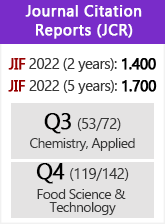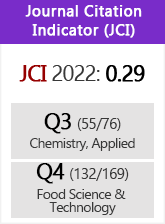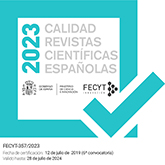The role of lipids in nonenzymatic browning
DOI:
https://doi.org/10.3989/gya.2000.v51.i1-2.405Keywords:
Amino-carbonyl reactions, Maillard reaction, Nonenzymatic browning, Oxidized lipid-protein interactionsAbstract
The role of lipids in nonenzymatic browning is studied by reviewing oxidized lipid/protein reactions in comparison with other reactions where the production of browning is known: the Maillard reaction, the ascorbic acid browning, and the quinone/amine reactions. The mechanisms proposed in these reactions for production of color and fluorescence, as well as the formation of melanoidins, lipofuscins, and low molecular weight colored products are discussed comparatively, concluding that the role of lipids in these reactions does not seem to be very different to the role of carbohydrates in the Maillard reaction or the phenols in the enzymatic browning. These carbonyl-amine reactions seem to be a group of gradual, partially reversible, universal, and inevitable side reactions in both food and biological systems. However, most of these results were obtained in model systems and additional studies should be carried out in systems closer to real foods or living beings, which should provide a more complete understanding of nonenzymatic browning, and, therefore, to afford a much more comprehensive knowledge of food and human biochemistry.
Downloads
Download data is not yet available.
Downloads
Published
2000-04-30
How to Cite
1.
Hidalgo FJ, Zamora R. The role of lipids in nonenzymatic browning. Grasas aceites [Internet]. 2000Apr.30 [cited 2024Jul.27];51(1-2):35-49. Available from: https://grasasyaceites.revistas.csic.es/index.php/grasasyaceites/article/view/405
Issue
Section
Research
License
Copyright (c) 2000 Consejo Superior de Investigaciones Científicas (CSIC)

This work is licensed under a Creative Commons Attribution 4.0 International License.
© CSIC. Manuscripts published in both the printed and online versions of this Journal are the property of Consejo Superior de Investigaciones Científicas, and quoting this source is a requirement for any partial or full reproduction.All contents of this electronic edition, except where otherwise noted, are distributed under a “Creative Commons Attribution 4.0 International” (CC BY 4.0) License. You may read here the basic information and the legal text of the license. The indication of the CC BY 4.0 License must be expressly stated in this way when necessary.
Self-archiving in repositories, personal webpages or similar, of any version other than the published by the Editor, is not allowed.
















